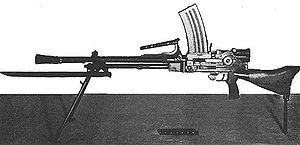Type 99 light machine gun: Difference between revisions
m updating link using AWB |
|||
| Line 37: | Line 37: | ||
==See also== |
==See also== |
||
{{Commonscat|Type 99 LMG}} |
{{Commonscat|Type 99 LMG}} |
||
* [[Mendoza RM2]] |
|||
* [[Lahti-Saloranta M/26]] |
* [[Lahti-Saloranta M/26]] |
||
* [[FM-24/29]] |
* [[FM-24/29]] |
||
Revision as of 11:57, 21 July 2008
| Type 99 Light Machine Gun | |
|---|---|
 Type 99 LMG | |
| Type | machine gun |
| Place of origin | |
| Service history | |
| Used by | Japan |
| Wars | WWII |
| Production history | |
| Designer | Kijiro Nambu |
| Designed | 1939 |
| Specifications | |
| Mass | 11.4 kg |
| Length | 1181 mm |
| Barrel length | 550 mm |
| Cartridge | 7.7x58mm Arisaka |
| Action | Gas operated |
| Rate of fire | 250 to 900 round/min |
| Muzzle velocity | 715 m/s (2,300 ft/s) |
| Feed system | 30 round |
The Type 99 Light Machine Gun was a light machine gun produced by Japan during the Second World War. It entered service in 1939.
Because Japan had adopted the 7.7 mm Type 99 Rifle an accompanying 7.7 mm light machine gun was also developed. The Type 99 was the basically same design as the Type 96 light machine gun, but the Type 99 dispensed with the oiler and had better primary extraction. Early models had a mono-pod at the stock and a flash-hider at the muzzle which was screwed onto a threaded portion of the barrel. Like the Type 96, most were issued with a 2.5 power optical sight. These were often issued to the best marksmen of the unit and occasionally employed like a sniper rifle. It also served as a light anti-aircraft gun occasionally during the war. The gun shares the shape of the British Bren gun and the Czech ZB26, however, internally it is quite different from both.
References
- Leo J. Daugherty III, Fighting Techniques of a Japanese Infantryman 1941-1945, ISBN 1-86227-162-3
- Japanese Model 99 MG, Tactical and Technical Trends No. 35, U.S. War Department.
